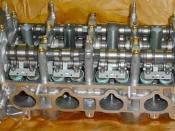In case you are not familiar with the basics of how an internal combustion engine works, it goes something like this. The piston is connected to a connecting rod that is connected to the crank. The crankshaft is connected to the cam by using a belt or chain. The cam opens and closes the valves, letting air in and exhaust out. Each time the piston is forced up or down, that is called a stroke. The piston starts at the top of the engine, the intake valves open, and the piston moves down to let the engine take in air and gasoline. Then the piston moves back up to compress the air and fuel. When the piston reaches to the top of its stroke, a spark is created from a spark plug that ignites the gasoline. The gasoline in the cylinder explodes, driving the piston down. Once the piston hits the bottom of its stroke, the exhaust valve opens and lets the exhaust out.
Now the engine is ready to repeat this process called a cycle.
In recent years, the most technically advanced innovation to happen to sport compact cars was the introduction of Honda's VTEC. VTEC stands for Variable Valve Timing and Lift Electronic Control. Honda paved the way for this type of technology. Honda first developed VTEC for its Indy car race team; then, in 1990, introduced VTEC into the Acura NSX (owned by Honda). Then in 1992, it was introduced into the sport compact car world in the Honda Civic for that model year.
The basics of Honda's VTEC system are the camshafts have two different profiles of cam lobes on the camshaft; one lobe for short duration and low lift and one lobe for high duration and high lift. In Honda's system, above 4800 rpm's, an...


